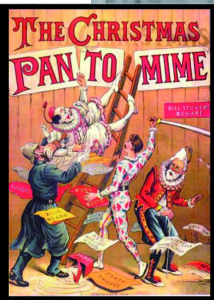A traditional English form of holiday entertainment, particularly associated with Boxing Day, December 26th. Pantomime or “panto”, developed in the 18th century and grew out of the commedia dell’arte harlequin plays popular at the time. Such plays were usually preceded by scenes of mimed and danced action. The first true panto is said to have been the 1717 “Harlequin Executed” presented by John Rich. Gradually, as words, comic turns and stage effects were added, the pantomime grew more popular than the plays that gave them birth, emerging as colourful, costumed spectacles based on fairy tales.
Popular throughout the 18th and 19th centuries panto remains a customary part of the English Christmas season despite, or perhaps because of, its predictability. In plays such as “Cinderella”, “Jack and the Beanstalk”, or Aladdin” the hero or “principal boy” is always played by an attractive actress in a form-fitting costume while the “Dame”, an ugly old woman, is played by a male comedian. Other features of the panto include atrocious puns, ritual shouted exchanges between the actors and the audience, appearances by celebrities and references to current events.
An early nineteenth-century account of a family in attendance: “But oh, the rapture when the pantomime commences! Ready to leap out of the box, they joy in the mischief of the clown, laugh at the thwacks he gets for his meddling, and feel no small portion of contempt for his ignorance in not knowing that hot water will scald and gunpowder explode; while with head aside to give fresh energy to the strokes, they ring their little palms against each other in testimony of exuberant delight.”
